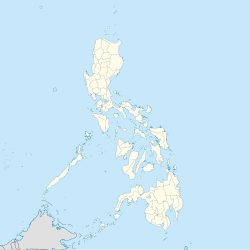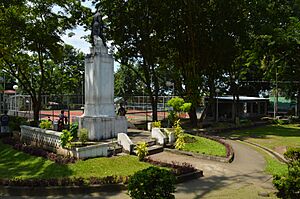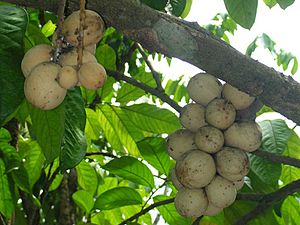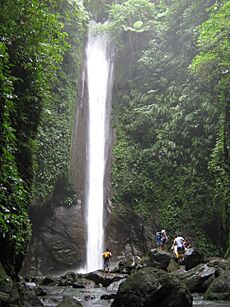Valencia, Negros Oriental facts for kids
Quick facts for kids
Valencia
|
|||
|---|---|---|---|
| Municipality of Valencia | |||
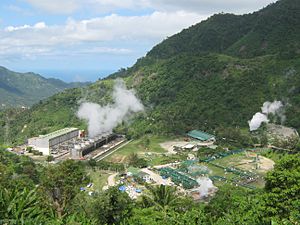
Palinpinon Geothermal Power Plant in Barangay Puhagan
|
|||
|
|||

Map of Negros Oriental with Valencia highlighted
|
|||
|
OpenStreetMap
|
|||
| Country | Philippines | ||
| Region | Negros Island Region | ||
| Province | Negros Oriental | ||
| District | [[{{#property:P7938}} | — Lua error in Module:Wd at line 1804: attempt to index field 'wikibase' (a nil value).]] | ||
| Barangays | 24 (see Barangays) | ||
| Government
|
|||
| • Type | Sangguniang Bayan | ||
| Area | |||
| • Total | 147.49 km2 (56.95 sq mi) | ||
| Elevation | 275 m (902 ft) | ||
| Highest elevation | 1,276 m (4,186 ft) | ||
| Lowest elevation | 21 m (69 ft) | ||
| Population | |||
| • Total | 38,733 | ||
| • Density | 262.614/km2 (680.17/sq mi) | ||
| • Households | 9,255 | ||
| Economy | |||
| • Income class | 1st municipal income class | ||
| • Poverty incidence |
|
||
| • Revenue | ₱ 304.6 million (2022) | ||
| • Assets | ₱ 1,603 million (2022) | ||
| • Expenditure | ₱ 238.2 million (2022) | ||
| • Liabilities | ₱ 692.7 million (2022) | ||
| Service provider | |||
| • Electricity | Negros Oriental 2 Electric Cooperative (NORECO 2) | ||
| Time zone | UTC+8 (PST) | ||
| ZIP code |
6215
|
||
| PSGC |
[https://psa.gov.ph/classification/psgc/?q=psgc/barangays/{{#pro000®code={{&provcode=
|
||
| IDD : area code | +63 (0)35 | ||
| Native languages | Cebuano Tagalog |
||
| Named after | Valencia, Spain | ||
Valencia is a beautiful town in the province of Negros Oriental, Philippines. It is officially known as the Municipality of Valencia. In 2020, about 38,733 people lived there.
Valencia was named the "greenest and cleanest" town in Negros Oriental in 2007. This shows how much the community cares for its environment. The town celebrates its patroness, Our Lady of the Abandoned, every year on October 12. This day is a special holiday for everyone in Valencia.
Contents
History of Valencia
How Valencia Got Its Name
Valencia was first called Ermita. This name means "a secluded place." It was a safe spot for people to hide from pirates who attacked from the sea.
In 1856, the Spanish changed its name to Nueva Valencia. This was to honor Father Matias Villamayor, a priest from Valencia, Spain. He even brought a special fountain from his hometown, which you can still see in front of the Town Hall today.
Later, in 1920, the town was renamed Luzuriaga. This was to thank Don Carlos Ruíz de Luzuriaga. He was a leader from Negros island who promised to help improve the town. However, in 1948, the town went back to being called Valencia.
Valencia During World War II
During World War II, the area of Malabo in Valencia became very important. It was the secret headquarters for the Free Government and the resistance movement in Negros Oriental. Brave Filipinos fought for freedom from there.
In 2007, the Valencia Municipal Police Station was recognized as the best police station in the Central Visayas region. This award showed their excellent work in keeping the town safe.
Exploring Valencia's Geography
Valencia covers an area of about 147 square kilometers. About 35% of this land is flat, while 65% is mountainous. The town's elevation is usually between 200 and 500 meters above sea level. The highest point is the top of Mount Talinis, which is 1,903 meters high. Because of its elevation, Valencia has a cool climate, especially in the higher areas.
Valencia is located just 10 kilometers west of Dumaguete, the provincial capital. It is also 7 kilometers from Bacong. The region is a very important watershed area. This means it collects and provides plenty of clean drinking water for Valencia and nearby towns.
Barangays: Valencia's Communities
Valencia is divided into 24 smaller communities called barangays. Each barangay has its own smaller areas called puroks and sometimes sitios.
| PSGC | Barangay | Population | ±% p.a. | |||
|---|---|---|---|---|---|---|
| 2010 | ||||||
| 074623001 | Apolong | Expression error: Missing operand for /.% | 1,732 | 1,496 | 0.94% | |
| 074623004 | Balayagmanok | Expression error: Missing operand for /.% | 1,472 | 1,106 | 1.84% | |
| 074623005 | Balili | Expression error: Missing operand for /.% | 607 | 487 | 1.42% | |
| 074623006 | Balugo | Expression error: Missing operand for /.% | 2,222 | 1,649 | 1.92% | |
| 074623007 | Bongbong | Expression error: Missing operand for /.% | 1,527 | 1,333 | 0.87% | |
| 074623008 | Bong-ao | Expression error: Missing operand for /.% | 3,228 | 2,226 | 2.40% | |
| 074623013 | Caidiocan | Expression error: Missing operand for /.% | 1,620 | 1,536 | 0.34% | |
| 074623009 | Calayugan | Expression error: Missing operand for /.% | 1,362 | 1,114 | 1.29% | |
| 074623010 | Cambucad | Expression error: Missing operand for /.% | 589 | 529 | 0.69% | |
| 074623011 | Dobdob | Expression error: Missing operand for /.% | 1,475 | 1,346 | 0.59% | |
| 074623002 | East Balabag | Expression error: Missing operand for /.% | 3,916 | 2,662 | 2.50% | |
| 074623012 | Jawa | Expression error: Missing operand for /.% | 2,639 | 1,964 | 1.91% | |
| 074623014 | Liptong | Expression error: Missing operand for /.% | 1,224 | 1,094 | 0.72% | |
| 074623015 | Lunga | Expression error: Missing operand for /.% | 1,044 | 885 | 1.06% | |
| 074623016 | Malabo | Expression error: Missing operand for /.% | 799 | 823 | −0.19% | |
| 074623017 | Malaunay | Expression error: Missing operand for /.% | 2,136 | 1,950 | 0.58% | |
| 074623018 | Mampas | Expression error: Missing operand for /.% | 513 | 413 | 1.40% | |
| 074623019 | Palinpinon | Expression error: Missing operand for /.% | 3,352 | 2,447 | 2.03% | |
| 074623020 | North Poblacion | Expression error: Missing operand for /.% | 738 | 752 | −0.12% | |
| 074623022 | Puhagan | Expression error: Missing operand for /.% | 1,986 | 1,548 | 1.61% | |
| 074623023 | Pulangbato | Expression error: Missing operand for /.% | 1,031 | 989 | 0.27% | |
| 074623024 | Sagbang | Expression error: Missing operand for /.% | 879 | 846 | 0.24% | |
| 074623021 | South Poblacion | Expression error: Missing operand for /.% | 557 | 602 | −0.50% | |
| 074623003 | West Balabag | Expression error: Missing operand for /.% | 2,085 | 1,680 | 1.39% | |
| Total | 31,477 | Expression error: Unexpected < operator.% | ||||
Valencia's Climate
Valencia has a tropical climate. It experiences warm temperatures throughout the year. The town also receives a good amount of rainfall. This helps keep its natural environment lush and green.
| Climate data for Valencia, Negros Oriental | |||||||||||||
|---|---|---|---|---|---|---|---|---|---|---|---|---|---|
| Month | Jan | Feb | Mar | Apr | May | Jun | Jul | Aug | Sep | Oct | Nov | Dec | Year |
| Mean daily maximum °C (°F) | 28 (82) |
29 (84) |
30 (86) |
31 (88) |
30 (86) |
29 (84) |
29 (84) |
29 (84) |
29 (84) |
28 (82) |
28 (82) |
28 (82) |
29 (84) |
| Mean daily minimum °C (°F) | 21 (70) |
21 (70) |
21 (70) |
22 (72) |
23 (73) |
23 (73) |
23 (73) |
23 (73) |
23 (73) |
23 (73) |
22 (72) |
21 (70) |
22 (72) |
| Average precipitation mm (inches) | 26 (1.0) |
22 (0.9) |
28 (1.1) |
41 (1.6) |
95 (3.7) |
136 (5.4) |
147 (5.8) |
126 (5.0) |
132 (5.2) |
150 (5.9) |
98 (3.9) |
46 (1.8) |
1,047 (41.3) |
| Average rainy days | 7.5 | 6.7 | 8.9 | 10.4 | 21.6 | 25.6 | 26.3 | 25.0 | 24.1 | 26.2 | 19.2 | 12.1 | 213.6 |
| Source: Meteoblue (Use with caution: this is modeled/calculated data, not measured locally.) | |||||||||||||
Valencia's Population and Languages
Population Growth Over Time
The number of people living in Valencia has changed over many years. You can see how the population has grown in the chart below. This information helps us understand the town's development.
Languages Spoken in Valencia
The main language spoken in Valencia is Cebuano. Many people also speak Tagalog and English. This mix of languages shows the diverse culture of the Philippines.
Valencia's Economy and Resources
| Source: Philippine Statistics Authority |
|
Valencia's economy mostly relies on agriculture. Farmers grow many different products. These include abaca, copra, corn, flowers, vegetables, and root crops. They also grow special fruits like lanzones and rambutan. These fruits are even sent to other towns!
Geothermal Power: A Big Energy Source
Valencia is home to a large geothermal power station. This station is run by the Energy Development Corporation. It uses heat from deep inside the Earth to make electricity. This electricity powers homes and businesses in Negros, Panay, and parts of Cebu. The local government also gets money from the power station, which helps the town.
The Palinpinon 2 Geothermal Optimization Project is a big part of this. It is located in Sitio Nasuji, about 35 kilometers from Dumaguete. This project helps supply power to eight provinces. Valencia's geothermal fields are among the largest in the country. They save a lot of money by producing clean energy.
Because Valencia is such a big source of geothermal energy, the town receives special funds. These funds are used for projects like livelihood programs and education. They also help reduce electricity bills for the people living in Valencia. Many residents also work in the nearby city of Dumaguete.
Fun Places to Visit in Valencia
Valencia is a great place for tourists who love nature and history.
- Filipino-Japanese Amity Memorial Shrine: This shrine is at the foot of Mount Talinis. It marks a special place where Filipino and American soldiers, along with local guerrilla fighters, bravely fought the Japanese army during World War II. It reminds us of their courage.
Nature and Adventure Spots
- Tejero Highland Resort and Adventure Park: This popular resort offers lots of fun activities. You can try a speed dual zipline, ride ATVs, or even try Aquazorb. It also has natural pools, a restaurant, and a hotel. It's very close to Dumaguete and a favorite spot for visitors.
- Casaroro Waterfalls: This is one of the most photographed waterfalls in the province. It's surrounded by beautiful green plants and natural rocks. The cool water flows down into a refreshing swimming hole.
- The Forest Camp Resort: This large camping ground has natural pools, cottages, and even a tree house. It's a perfect place for groups and students to enjoy nature.
- Banica Swimming Lagoon: Also known as Tejeros resort, it features two man-made pools. These pools are filled with fresh water from the Banica River.
- Malabo/Pulangbato Falls: This spot is great for swimming and diving. It's known for its unique reddish rocks.
- Red Rock Hot Spring: A relaxing dipping pool with warm, natural spring water.
- Mount Talinis: This is a tall peak, 1,903 meters high. It has several volcanic lakes and is home to many different kinds of plants and animals.
- Balinsasayao Twin Lakes Natural Park: This protected area is near Mount Talinis. It surrounds two beautiful lakes formed in old volcano craters. It's a great place to see nature.
Historical and Cultural Sites
- The Spanish Fountain: Located in the town plaza, this old fountain is a reminder of Valencia's past. It has a unique sunken design. Long ago, it was the main source of water for the town.
- Cata-al War Memorabilia: This is a private collection owned by Porforio Cata-al, a World War II survivor. It's like a small museum in his home. You can see old bombs, grenades, money, medals, and pieces of military uniforms from the war.
- Filipino-American-Japanese Amity Shrine: This shrine is on a hilltop in Sagbang. It's a three-sided pillar that represents the friendship between the Philippines, America, and Japan. It was built in 1977.
Education in Valencia
Valencia has many schools for children and teens. The public schools are managed by the Schools Division of Negros Oriental.
Elementary Schools
- Badiang Elementary School — Sitio Badiang, Pulangbato
- Balabag Elementary School — East Balabag
- Balili Primary School — Balili
- Balugo Elementary School — Balugo
- Bong-ao Elementary School — Bong-ao
- Bongbong Elementary School — Bongbong
- Caidiocan Elementary School — Caidiocan
- Calinawan Elementary School — Sitio Calinawan, Dobdob
- Dobdob Elementary School — Dobdob
- Dungga Primary School — Sitio Dungga, Malaunay
- Inas Elementary School — Sitio Inas, Dobdob
- Liptong Elementary School — Liptong
- Malabo Elementary School — Malabo
- Malaunay Elementary School — Malaunay
- Nasuji Elementary School — Sitio Nasuji, Puhagan
- Palinpinon Elementary School — Palinpinon
- Puhagan Elementary School — Puhagan
- Pulangbato Elementary School — Pulangbato
- Sagbang Elementary School — Sagbang
- Valencia Central Elementary School — Luna Street, North Poblacion
- Vicente I. Villa Memorial School — Apolong
High Schools
- Balugo National High School — Balugo
- Pulangbato National High School — Pulangbato
- Pulangbato National Senior High School — Palinpinon
- Valencia National High School — Bong-ao
- Valencia NHS - Dobdob Extension — Dobdob
Private Schools
- Colegio de San Pedro-Recoletos (formerly San Pedro Academy) — Rizal Street, South Poblacion
- Dumaguete Kalikasan Educational Center, Inc. — Bong-ao
- San Pedro Academy-Recoletos — Caidiocan
- ABC Learning Center - Valencia Branch
- Marymount Westridge School
Valencia's Local Government
Valencia is led by elected officials who work to improve the town. The mayor is the chief executive. The vice mayor and municipal council members also help make important decisions for the community.
Leaders of Valencia Over the Years
Here is a list of some of the leaders who have served Valencia:
- Mariano Imbo (Captain)
- Gerardo Imbo (1916 - 1919)
- Eustaquio Vincoy (1919 - 1927)
- Guillermo Albina (1928 - 1931)
- Quiterio Mariño (1931 - 1939)
- Jose Villamil (1940 - 1946)
- Rodolfo Gonzalez, Senior (1946 - 1967)
- Elpidio Unto (1968 - 1971)
- Rodolfo Gonzalez, Senior (1972 - 1980)
- Saludario Sonjaco (1981 - 1986)
- Victor Naces (1986 - 1987)
- Jose Villamil (Officer in Charge) (1987 - 1988)
- Edgar Teves (1988 - 1998)
- Humberto Sy (1998 - 2001)
- Rodolfo Gonzalez, Junior (2001 – 2010)
- Enrique Gonzalez (2010 - 2013)
- Edgar Teves (2013–2022)
- Edgar Teves, Jr. (2022–present)




